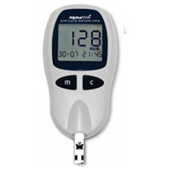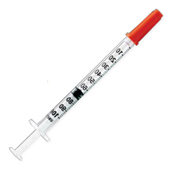To understand feline diabetes, you need to
understand how blood sugar levels are regulated in the body. Glucose
is a type of sugar. When a cat eats, her digestive system breaks
down many of the components of her meal into glucose, which is absorbed
into the blood stream. Rising blood glucose levels trigger the
pancreas to secrete insulin, a hormone that binds to glucose and moves
it out of the blood and into cells where it can be used as a source
of energy or converted into other substances and stored for later use.
"Neutered male cats are at the highest risk for developing diabetes."
When a pet has diabetes mellitus, her
pancreas either does not secrete enough insulin (i.e., Type One diabetes)
or her tissues cannot respond to the normal amounts of insulin that
are present (i.e., Type Two diabetes). In either case, there is
too much glucose in the blood and not enough within cells, and her body
cannot function normally.
How Did My Cat Get Diabetes?
Cats can develop both Type One and
Type Two diabetes. Obesity is the primary risk factor for the
development of Type Two diabetes, but other disorders like Cushing's
disease or the use of certain medications like glucocorticoids, may
also be involved.
Type One diabetes develops when the pancreatic
cells responsible for producing insulin are destroyed. The reason
why this occurs is usually unclear, but genetics and severe or reoccurring
pancreatic inflammation (i.e., pancreatitis) can play a role.
Neutered male cats are at the highest risk for developing diabetes.
The Effects of Diabetes in Cats
Owners of diabetic cats often notice
increased thirst and urination, weakness, and weight loss despite a
normal or even ravenous appetite. Reoccurring infections are also possible,
and cats may walk without fully straightening their hind legs or develop
cataracts as the disease progresses. Left untreated, severe diabetes
can cause electrolyte disturbances, extreme dehydration, seizures and
death, a condition known as diabetic ketoacidosis.
Diabetic Veterinary Care

Most cases of diabetes can be diagnosed
based on a combination of clinical signs, a higher than normal blood
glucose level, and the presence of glucose in the urine. Additional
lab work may be needed if the initial results are ambiguous.
In rare cases, pet medications will adequately lower blood sugar levels,
but the great majority of cats require insulin injections and a strictly
controlled diet to control their diabetes.
Diabetic regulation
is usually started in the veterinary hospital so that glucose levels
can be closely monitored. If a cat is suffering from diabetic
ketoacidosis, intravenous fluids and other treatments will be necessary
to stabilize her condition. Once a cat's diabetes is under reasonable
control, she is sent home.
Home Care for Diabetic Cats
Committed owners are key to successfully
managing feline diabetes. Insulin injections need to be given
at approximately the same time every day. Your veterinarian will
determine what type of insulin works best for your cat. Always
make sure to use the type of syringe that matches your pet's insulin.

A diabetic cat's appetite needs to
be closely monitored. High protein, low carbohydrate diets are
ideal and are usually prescribed by a veterinarian. If your cat
is not eating normally, call your vet. It is always safer to skip
an insulin injection than to give one when it is not needed. A low
blood sugar level (i.e., too much insulin) is much more dangerous in
the short term than is a high blood sugar level.
Regular monitoring of a diabetic cat's
glucose levels is very important. Owners can learn to do this
at home with a hand-held blood glucose monitor like the AlphaTRAK 2 or with urinary glucose detection systems. Cats can
also be brought into the veterinary clinic for the blood tests the give
an idea of the adequacy of glucose control over the last several days
or weeks.
Never increase your cat's insulin
dose without first talking to your veterinarian. If your cat is
acting confused, weak, or lethargic give her some food, do not give
any insulin, and call your vet. If your cat collapses or has a
seizure, rub a dissolved sugar solution, honey, or Karo syrup on her
gums and get her to the vet immediately.
Managing a diabetic cat takes dedication.
Some cats require life-long treatment. Others may eventually be
able to be weaned off their insulin injections, but still require rigorous
weight control, dietary modifications and close monitoring.
With proper care, however, many diabetic cats live happily for years
after their diagnosis.
The above is provided for information purposes only and should not be used for the diagnosis or treatment of any condition.
This information does not cover all possible variables, conditions, reactions, or risks relating to any topic, medication, or product and should not
be considered complete. Certain products or medications may have risks and you should always consult your local veterinarian concerning the treatment of
your pet. Any trademarks are the property of their respective owners.